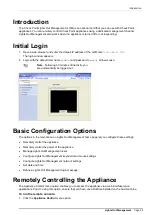
Page 24
Chapter 3
Configuring SmartEvent
This section explains how to get up and running with SmartEvent.
In This Chapter
Preparing SmartEvent on Security Management Server
Configuring the SmartEvent Clients
Preparing SmartEvent on Security
Management Server
To configure SmartEvent, first establish connectivity between the components.
1. Launch SmartDashboard.
2. In SmartDashboard, create a new host for each computer that contains a component of SmartEvent:
a) Select
Manage > Network Object > New > Check Point > Host
b) In the
General Properties
window, click
Communication
and enter the activation key.
Note
- If the Security Management Server and SmartEvent are installed on different sides of the firewall,
add a rule that allows SIC traffic between them.
c) The version is not entered automatically if the SmartEvent version is newer than the version of the
Security Management Server. If so, select the most recent version available from the
Version
drop-
down list.
d) In the
Management Software Blades
list, select the blades that are installed on the new host.
3. Install the database on all log servers from which SmartEvent reads data: select
Policy > Install
Database
and select the log servers as the targets.
4. To allow the SmartEvent Intro server to block attacks from specific IP addresses, configure the Security
Management Server to accept SAM commands from the SmartEvent Intro server:
a) On the Security Management Server, edit the
$CPDIR/conf/sic_policy.conf
file:
Search for the section
[Inbound rules]
, and add the following line under
# sam proxy
:
DN_Mgmt ; Reporting_Tool; ANY; sam ; sslca
b) From the command line in the Security Management Server computer, run the following commands:
cpstop
cpstart
Configuring the SmartEvent Clients
You must perform these configurations to make the components of the SmartEvent functional.
After you have accomplished the tasks for SmartEvent Intro, events will begin to appear in the SmartEvent
Intro client.
After you have accomplished the tasks for SmartReporter, logs will be created and sent to the
SmartReporter database. Reports can then be created.






























